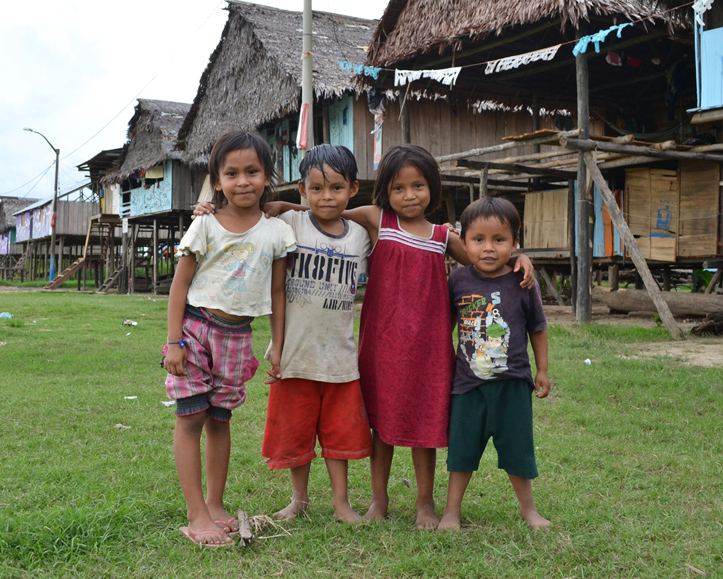

Empowering farmers and fighting inequality in Peru

Indigenous children from Peru’s remote regions are among the most disadvantaged in the world: in some areas, half the children suffer from chronic malnutrition and many are anemic and Vitamin A deficient.
Extreme inequalities, coupled with lack of services, poor roads and schools and the worst social and health indicators in the country, make prospects for these youngsters grim.
Yet farmers like 40-year-old Luís Antonio Arone León, whose region of Ayacucho was devastated during the 1980s guerilla war, are getting assistance from the MDG-Fund to help turn things around. Through training programs known as Farmers Field Schools, they are being taught better agricultural and management techniques that will improve their children’s health and nutrition.
“I have a commitment to my community to help it get out of the poverty caused by the political violence,” says Arone, president of the Community Development Corporation of his village of Chullcupampa. “We’re growing through the Farmers Field School, learning that planting an acre of seedlings can lift us out of poverty.”
Empowering farmers
One in three children under the age of 5 suffer from chronic malnutrition in Arone’s region. An MDG-F-funded UN joint programme is working there and in three other regions of Peru to strengthen the capacity of social workers and health, agricultural and technical professionals to help families improve their farming and animal husbandry practices.
"We’ve learned to fumigate, to prepare compost and to use biological methods and pest control to increase our production,” says Arone, who was trained by the programme to be a facilitator, and to pass on this training to other farmers in his community. “We share knowledge, we dialogue in order to learn agricultural techniques, we put our ideas together and what comes out is perfect.”
And the value of the training goes beyond farming, says Arone: “Not only have we learned things related to agriculture, we’ve also learned things that help us in organizing the community.”
Reducing inequalities
The programme, “Improving Nutrition and Food Security for the Peruvian Child: a Capacity Building Approach,” is part of the MDG-Fund’s effort to fight inequality around the world and to assist governments in meeting the anti-poverty Millennium Development Goals.
Peru has some of the greatest inequalities in Latin America, itself the most unequal region in the world. In the coastal region of Ica, for example, 15% of people live below the poverty line, compared to 85% in the adjacent region of Huancavelica, where many indigenous populations live.
To help address these differences, the MDG-F funds programmes in Peru to improve nutrition, manage climate change, increase youth employment and develop culture as a way to boost household incomes.
So far, the Farmers Field Schools initiative has trained 197 facilitators, who have in turn benefitted 4,661 poor families in the regions of Ayacucho, Apurímac, Huancavelica and Loreto. The programme is based on concepts like inclusion, rural research and participation; facilitators are also trained in cross-cutting areas such as Health, Nutrition, Risk Management and Best Practices in agriculture.
Domingo Díaz Cisneros, a technician from the Ministry of Agriculture and a facilitator trained by the programme, explains that the methodology of the Farmer Field Schools is to build a strong bond of trust between the trainers and the farmers. This is achieved by valuing and honoring the farmers’ ancestral knowledge and by involving the trainers in the entire cycle of planting and animal breeding.
At first, says Cisneros, many peasants did not believe that technical assistance would improve their farming, but, thanks to the training, they’ve been won over: “Now I have people coming to me and asking to be trained,” he says.
And the programme is also improving life for the region’s women: “Before, we had no gender equality in the community,” says Chullcupampa’s Arone . “Women were discriminated against because it was thought that they wouldn’t work in the fields. But the Farmers Field School taught us that the work is done equally, and now we even participate with our children,” he adds.
Improving nutrition and food security
“Improving Nutrition and Food Security for the Peruvian Child: a Capacity Building Approach” is a collaboration between the Peruvian government and UNICEF, WHO, UNODC, WFP and FAO. It supports Peru’s effort to improve food security and nutrition in four of the country's poorest regions by accelerating implementation of the National Strategy “CRECER.”
The programme works on the social roots of food insecurity and malnutrition through integrated interventions, targeting 64 districts with a population of 710,000, mostly members of Peru’s indigenous communities.